Do you often organize or host a grilling party at home? Why not add a DIY Yakitori grill to your outdoor cooking arsenal! Sure, you can buy one from the store, but you can also easily DIY one!
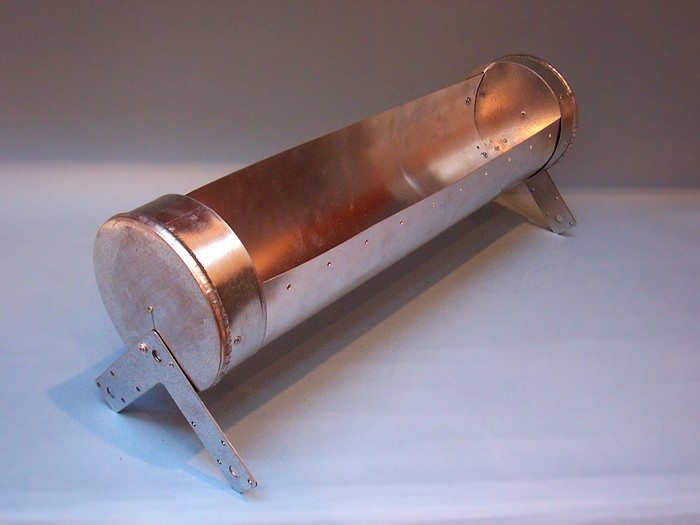
This DIY project is doesn’t involve any welding. You can easily put it together since the materials are not hard to find.
You will need a number of natural wine corks for holding the skewers and the grill while it’s in use. If you don’t have enough corks in your storage, you can purchase heaps from Amazon!
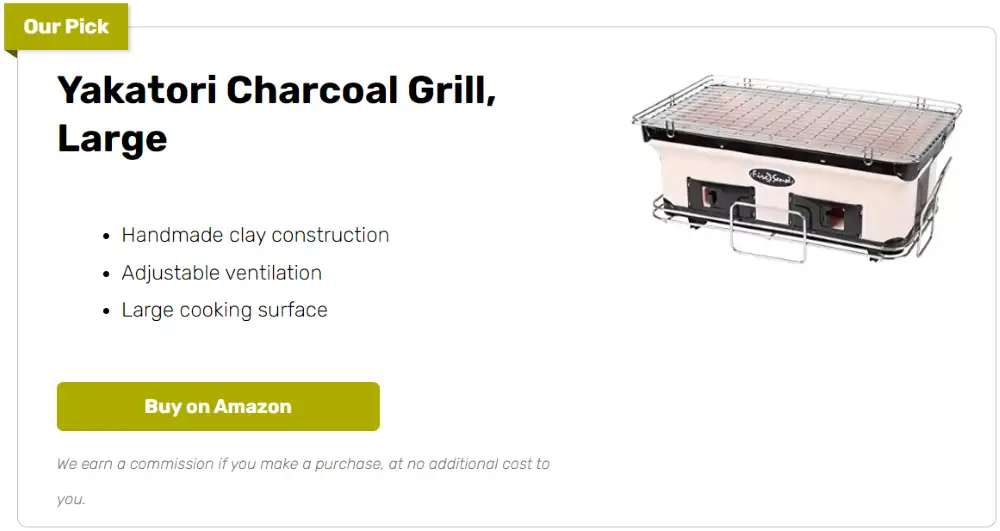
Contents
DIY Yakitori Grill: 10 Effortless Building Steps
Learn how to make your own Yakitori grill now by heading over to the tutorial linked below! But before that, have a look at our gallery of DIY Yakitori grills for inspiration. It also includes a welded version if you are into that type of build. :)
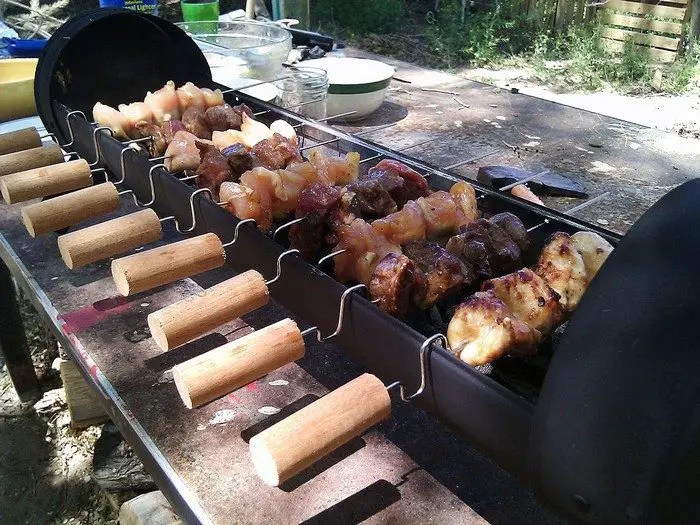
Building a DIY Yakitori Grill
Now, how about some Japanese yakitori at your next backyard party?
Materials:
- 1 pc Aluminum Sheet
- 2 pcs 6×2 Steel L-Straps
- High Temp Spray Paint
- 1/8″ diameter Stainless Steel Rod (for skewers)
- Charcoal
- #4-40 x 2′ Flat Head Machine Screws (with matching nuts and washers)
- Stainless Steel Rivet Washers
- Natural Wine Corks
- 2 Aluminum 6″ Cake Pans
Tools:
- Ruler
- Marker
- Hammer
- Drill
- Pop Rivets
- Rivet Gun
- Pliers
- Hobby Knife
- Aviation Tin Snips
Instructions:
Prepare the Aluminum Sheet
- Measure and Mark
- Start by laying your aluminum sheet on a flat surface. Use a ruler and marker to measure a rectangular base, ideally around 24″ x 12″—but feel free to adjust the size to fit your needs. Draw clear lines to guide where you’ll cut.
- Cut the Aluminum
- With an aviation tin snip, carefully cut along the marked lines. Go slow and steady to make clean cuts, and double-check your measurements to ensure everything is accurate.
Fold Edges for Safety
- Why This is Important?
- Folding the edges upward will not only keep the charcoal in place but also protect you from sharp edges.
- Folding the Edges
- Use a pair of pliers to bend about 1 inch of each side of the aluminum sheet upwards. As you bend, use the hammer gently to ensure the folds are firm and even. This small detail makes your grill safer and easier to handle.
Attach the Steel L-Straps
- Position the Legs
- Place one L-strap on each short side of your aluminum base. These straps will act as the legs for your grill, giving it a stable base and allowing airflow under the charcoal pans.
- Mark and Drill Holes
- Mark the spots where you’ll attach the L-straps, then use a drill to make holes through both the aluminum sheet and the L-straps. This will keep them firmly in place.
- Secure with Rivets
- Place a pop rivet into each hole, then use your rivet gun to secure the straps to the grill base. This will give your grill a solid structure.
Prepare the Skewer Rods
- Cutting the Rods
- Use your ruler and marker to measure the length for each skewer—about 12 inches each is a good length for grilling. Cut your stainless steel rod into these lengths
- Smooth the Ends
- To avoid sharp edges, use a file or sandpaper to smooth out the ends of each skewer rod. This makes them safer to handle while cooking.
Drill Skewer Holes Along the Grill Base
- Mark the Hole Positions
- On both long sides of the grill base, use your ruler to evenly mark where each skewer will sit. These marks should be about an inch apart.
- Drill the Holes:
- Drill a hole at each mark, making sure each one is just slightly larger than the diameter of your skewer rods. This allows the skewers to slide in and out easily while cooking.
Paint the Grill for Protection
- Apply High-Temperature Spray Paint
- Spray an even layer of high-temp paint over the entire grill to protect it from heat and rust. This will make your grill not only look good but also last longer outdoors.
- Let It Dry Completely
- Leave the grill in a well-ventilated space to dry. Make sure it’s completely dry before moving to the next steps to avoid smudging.
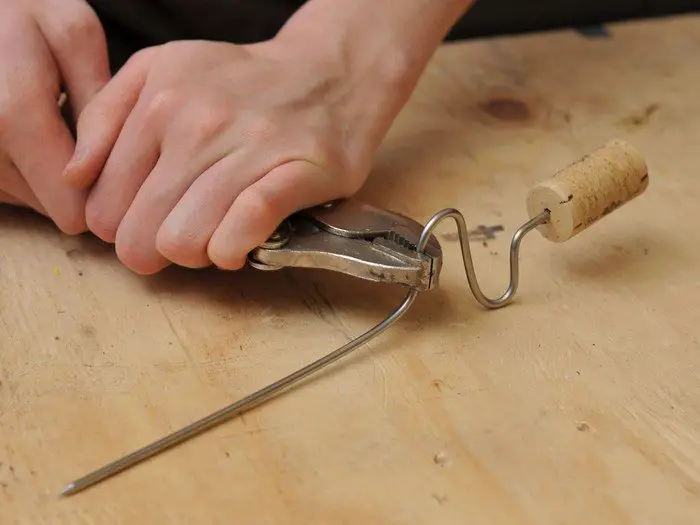
Attach the Handles Using Wine Corks
- Prepare the Corks
- Take two wine corks, which will serve as easy-to-grip handles for your grill.
- Drill Holes in the Corks
- Carefully drill a small hole through the center of each cork.
- Attach to the Grill
- Insert a machine screw through each cork hole and attach it to the sides of your grill. Secure with nuts and washers to ensure they’re firmly in place. These handles make your grill much easier to carry and adjust when hot.
Add the Charcoal Pans
- Position the Pans Inside the Grill
- Take two aluminum cake pans and place them side by side inside the grill base. These pans will hold the charcoal, making it easy to keep the heat contained and even, and simplifying cleanup afterwards.
Final Assembly and Check
- Inspect Your Grill
- Double-check that every part is secure and all screws, rivets, and attachments are tight
- Test the Skewers
- Insert each skewer rod into the holes to confirm they fit snugly and align well across the grill base.
Testing Your Grill
- Do a Dry Run
- Before adding food, light some charcoal in the pans for a test run. Check that the grill remains stable, that there’s sufficient airflow, and that the heat distributes evenly.
- Get Ready to Grill
- Once everything checks out, your DIY yakitori grill is ready for some action!
Click on any image to start the lightbox display. Use your Esc key to close the lightbox.![]()

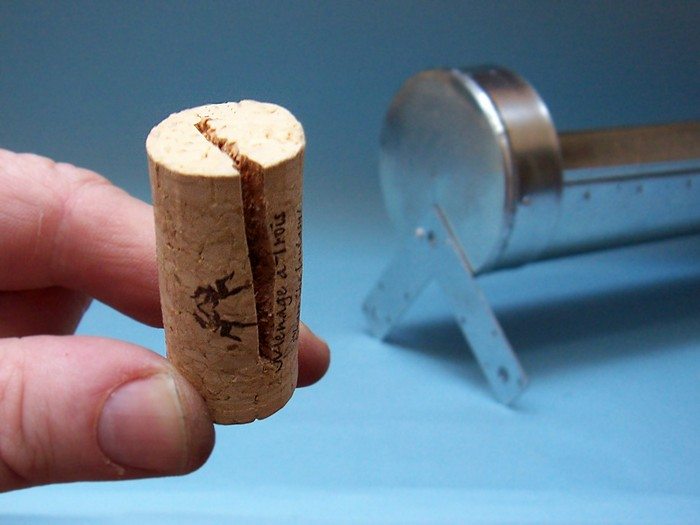

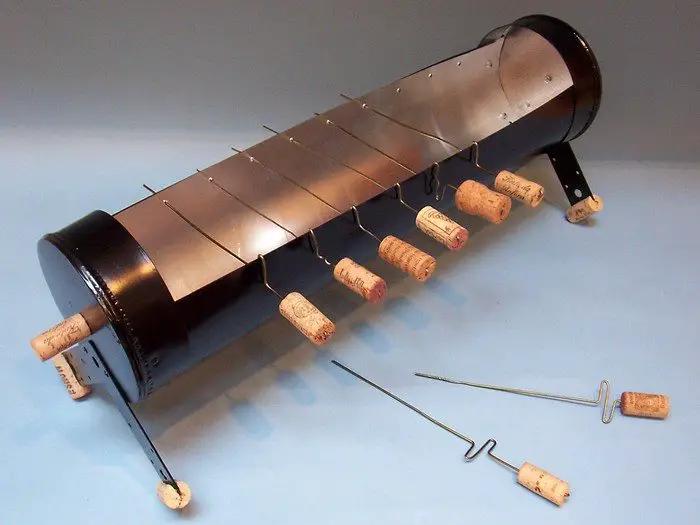
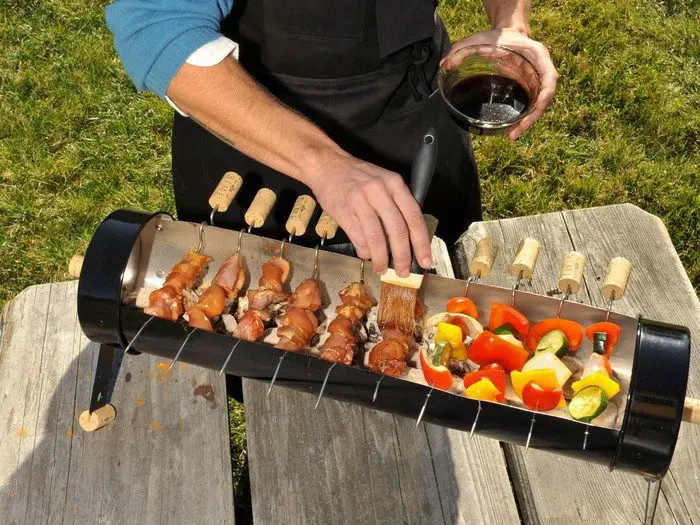

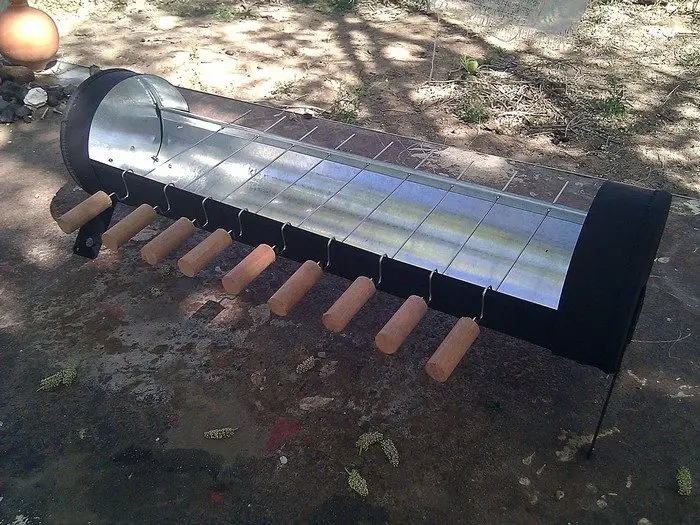
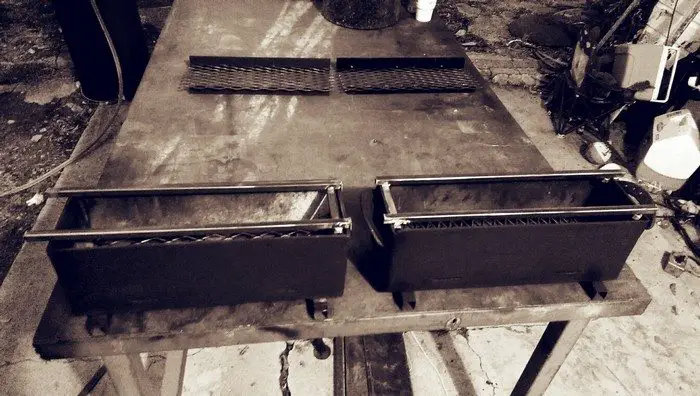
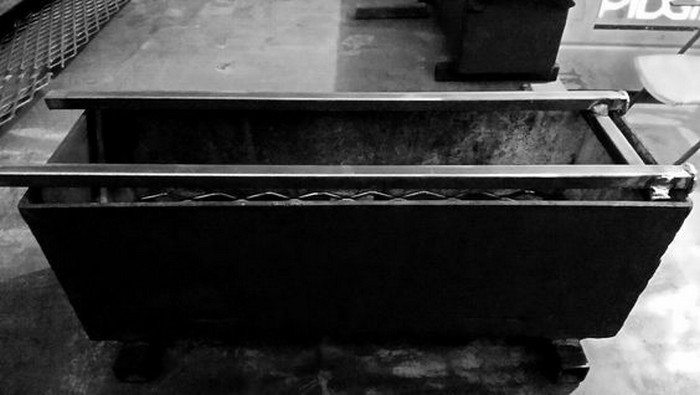
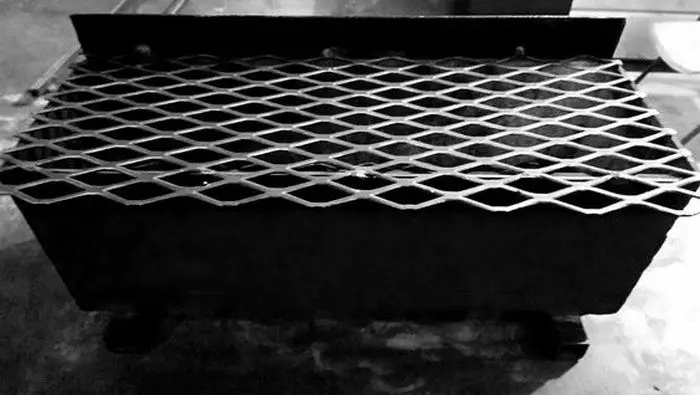
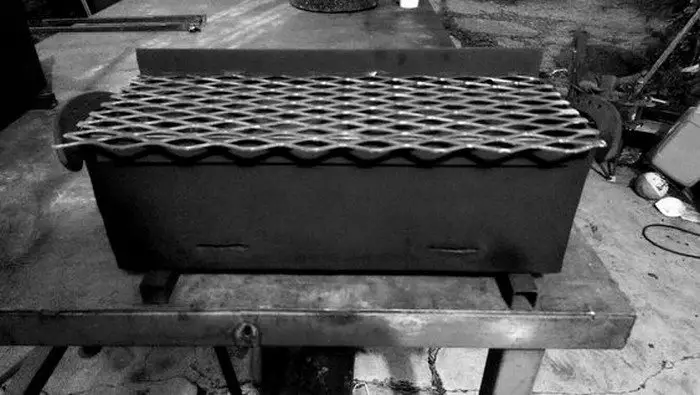
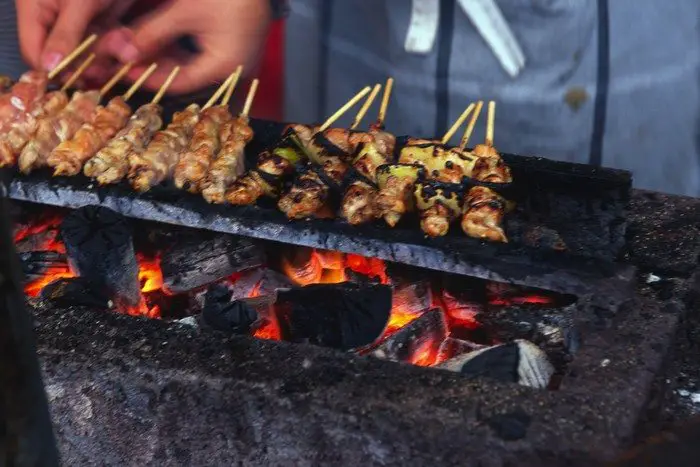
Cooking Tips and Recipes for Your DIY Yakitori Grill
Once you’ve built your DIY yakitori grill, it’s time to explore the delicious world of grilling. Yakitori is not just about skewered chicken; it’s a versatile cooking style that brings out the best in a variety of ingredients.
Here are some tips and recipes to get you started.
Grilling Techniques
- Preheat the Grill
- Ensure your grill is hot before you start. This helps in cooking the skewers evenly.
- Skewering
- When skewering, leave a little space between pieces. This ensures even cooking.
- Turning Skewers
- Regularly turn your skewers. This prevents burning and cooks food evenly.
- Sauce Application
- If you’re using a sauce, apply it towards the end of cooking. This keeps the flavor fresh and prevents burning.
Classic Chicken Yakitori
Ingredients:
- Chicken thighs, cut into bite-sized pieces
- Salt and pepper, to taste
- Yakitori sauce (store-bought or homemade)
Instructions:
- Season the chicken with salt and pepper. Skewer the chicken pieces.
- Place skewers on the preheated DIY yakitori grill. Grill each side for about 2-3 minutes.
- Brush yakitori sauce over the chicken during the last minute of grilling.
- Serve hot off the grill.
Vegetable Medley Skewers
Ingredients:
- Bell peppers, cut into squares
- Zucchini, sliced
- Cherry tomatoes
- Onion chunks
- Olive oil
- Salt and pepper, to taste
Instructions:
- Thread the vegetables onto skewers. Brush with olive oil and season with salt and pepper.
- Grill on your DIY yakitori grill for about 2-3 minutes on each side, or until desired tenderness is reached.
- Serve as a side dish or a vegetarian option.
Shrimp Yakitori
Ingredients:
- Large shrimp, peeled and deveined
- Lemon juice
- Garlic powder
- Salt and pepper, to taste
Instructions:
- Marinate shrimp in lemon juice, garlic powder, salt, and pepper for 15 minutes.
- Skewer the shrimp and grill on your DIY yakitori grill for 2 minutes on each side, or until cooked through.
- Serve with a side of lemon wedges.
Customization Ideas for Your DIY Yakitori Grill
Creating a DIY yakitori grill is not just about functionality; it’s also an opportunity to inject your personal style and preferences into the design. Here’s how you can customize your grill to make it uniquely yours.
Paint and Color
The color of your DIY yakitori grill is essential for its appearance and fitting into your outdoor space. Choose a shade that complements your surroundings and reflects your personality, like bold red or subtle green. Use stencils and high-temperature paint to add designs and patterns that withstand grilling heat, from simple geometric shapes to intricate designs. This personal touch transforms your grill into a unique piece of art.
Material Upgrades
Choose stainless steel sheets for your DIY yakitori grill for a stylish, durable finish. Customize skewer handles with heat-resistant materials like colored beads for a personalized touch. Add a splash of color while improving functionality.
Add-On Features
The addition of adjustable height to your DIY yakitori grill is a game-changer in terms of its functionality. This feature allows you to control the proximity of the food to the heat source, which is crucial for cooking different types of food perfectly.
For instance, delicate vegetables may require less heat, while thicker cuts of meat might need more intense heat for a good sear. With an adjustable height mechanism, you can easily cater to these needs, enhancing your overall grilling experience.
Incorporating foldable side tables is another practical enhancement for your DIY yakitori grill. These tables offer valuable space for keeping everything you need within arm’s reach. Imagine having a convenient place to set your marinades, sauces, plates, utensils, or even a refreshing drink as you grill.
These tables can fold down when not in use, making them a space-saving addition that’s perfect for smaller patios or balconies. The convenience and efficiency these tables bring to your grilling sessions make them an invaluable addition to your DIY project.
Personalized Branding
Personalizing your DIY yakitori grill with a metal nameplate or etching your logo onto it transforms the grill from a mere cooking tool to a reflection of your identity and creativity. This form of branding is an excellent avenue to showcase your craftsmanship and the pride you take in your creation.
Whether it’s your name, a special date, or a unique logo that represents you or your family, this personal touch adds a level of sophistication and ownership to the grill. Etching can be done through various methods, depending on the tools available and your skill level, giving your grill a professional finish.
This personalized branding does more than just make your grill look good; it tells a story, your story, making the grill not just a part of your backyard but a part of your personal history.
Eco-Friendly Touches
Incorporating eco-friendly elements into your DIY yakitori grill is not only good for the environment but also adds a unique aspect to your grill. One innovative way to do this is by installing small solar panels.
These panels can power LED lights or other small electronic components of your grill, reducing energy consumption and making your grilling sessions more sustainable. This addition is particularly beneficial for those who enjoy evening grilling, as it provides a renewable energy source for lighting.
Using recycled or upcycled materials in the construction of your grill is another step towards eco-friendly living. This could involve repurposing old metal sheets or using reclaimed wood for side tables. Not only does this approach minimize waste, but it also adds character and history to your grill.
Each recycled material brings its own story, and using these materials can create a conversation piece as much as a functional cooking tool. Embracing these eco-friendly practices not only contributes to a healthier planet but also gives a sense of fulfillment, knowing that your DIY project is environmentally responsible.
Maintenance and Care for Your DIY Yakitori Grill
Proper maintenance and care are crucial for ensuring the longevity and safety of your DIY yakitori grill. Regular upkeep not only keeps your grill in good working condition but also enhances your grilling experience. Here’s how you can maintain and care for your grill.
Regular Cleaning
Regular cleaning is essential for any grill, and your DIY yakitori grill is no exception. After each use, allow the grill to cool down and then clean the grates and interior surfaces. Remove any food particles or grease to prevent buildup and potential flare-ups. For the grates, use a grill brush or a scraper to remove residue. If your grill has removable parts like pans or trays, wash them with warm soapy water.
Protecting the Surface
Since your grill is likely to be exposed to various weather conditions, protecting its surface is important. If you’ve painted your grill with high-temp paint, check periodically for any chips or scratches. A touch-up may be needed to prevent rust. If your grill is made of stainless steel, wipe it down with a stainless steel cleaner to maintain its shine and prevent corrosion.
Checking for Wear and Tear
Regularly inspect your DIY yakitori grill for signs of wear and tear. Pay special attention to areas like hinges, screws, and the grill base. Tighten any loose parts and replace any that are worn out or damaged. This not only ensures your grill’s stability but also its safety during use.
Storage Solutions
When not in use, especially during off-season months, store your DIY yakitori grill in a dry, covered area. If you don’t have a storage space, consider using a grill cover to protect it from the elements. This will help prevent rust and keep your grill clean and ready for its next use.
Seasonal Maintenance
Before the grilling season begins, give your grill a thorough inspection and cleaning. This includes checking all components and giving it a good clean inside and out. This preparation ensures your grill is safe and ready for another season of delicious grilling.
Conclusion
Building and using a DIY yakitori grill is a rewarding experience that combines the joys of crafting with the pleasures of cooking. By following these guidelines and tips, you can create a durable, functional, and personalized grill that reflects your style and meets your grilling needs.
Looking to make your porch the ultimate cooking station? Check out our building guide for your own smokehouse pizza oven!
FAQ for DIY Yakitori Grill
- What is a yakitori grill?
- A yakitori grill is a traditional Japanese grill used to cook skewered meat, particularly chicken. These grills are compact and designed to produce high heat using charcoal, giving yakitori its signature smoky flavor. The most common type of charcoal used is binchotan.
- Can I use a gas grill for yakitori?
- Yes, although a gas grill can be used, it won’t provide the same level of smoky flavor that a charcoal grill offers. If you use a gas grill, you can add wood chips to create a similar smoky effect.
- Yes, although a gas grill can be used, it won’t provide the same level of smoky flavor that a charcoal grill offers. If you use a gas grill, you can add wood chips to create a similar smoky effect.
- Can I use my yakitori grill indoors?
- You should avoid using a charcoal yakitori grill indoors due to fire hazards and carbon monoxide risk. If you prefer indoor cooking, an electric yakitori grill is a safer alternative.
- You should avoid using a charcoal yakitori grill indoors due to fire hazards and carbon monoxide risk. If you prefer indoor cooking, an electric yakitori grill is a safer alternative.
- How do I clean my yakitori grill?
- Let the coals burn out before cleaning. Remove the grate and brush off any residue. Do not pour water directly on the grill, especially if it’s made of ceramic or clay, to prevent cracking.
- Let the coals burn out before cleaning. Remove the grate and brush off any residue. Do not pour water directly on the grill, especially if it’s made of ceramic or clay, to prevent cracking.
- How do I prevent food from sticking to the grill?
- Preheat the grill and apply a light coating of oil on the grill grates or the skewers to prevent sticking. Also, make sure the skewers are not overcrowded.
- Can I customize the size of my DIY yakitori grill?
- Yes, you can customize the size. Adjust the measurements of the materials according to the space available and your grilling needs.
- How often should I clean my DIY yakitori grill?
- Clean your grill after each use. This prevents the buildup of grease and food particles, which can affect taste and grill performance.
- Is it safe to paint my grill?
- Yes, it is safe to paint your grill, but ensure you use high-temperature resistant paint designed for grills and outdoor use.
- Can I leave my DIY yakitori grill outdoors?
- While the grill can be left outdoors, it’s best to cover it or store it in a dry place to protect it from weather and extend its life.
- What should I do if my grill starts to rust?
- If you notice rust, sand the affected area lightly and apply a coat of high-temp paint. Regular maintenance can prevent rust.





